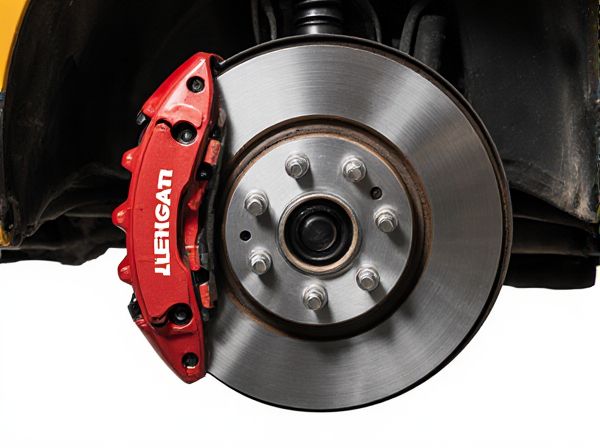
Photo illustration: Single-Piston Caliper vs Multi-Piston Caliper
Single-piston calipers provide sufficient stopping power for everyday driving and are generally more affordable and easier to maintain. Multi-piston calipers, on the other hand, offer enhanced braking performance and better heat dissipation, making them ideal for high-performance or heavy-duty vehicles. Choosing the right caliper depends on your driving needs and the level of brake performance desired.
Table of Comparison
| Feature | Single-Piston Caliper | Multi-Piston Caliper |
|---|---|---|
| Design | One piston applies pressure on brake pads | Two or more pistons distribute pressure evenly |
| Braking Power | Moderate, suitable for everyday driving | Higher, ideal for performance and heavy-duty use |
| Heat Dissipation | Lower, can lead to brake fade under stress | Better, reduces heat buildup and improves longevity |
| Cost | Economical and easier to maintain | More expensive due to complexity and performance parts |
| Weight | Lighter, improves fuel efficiency | Heavier, may affect vehicle handling |
| Ideal Use | Daily commuting and light vehicles | Sport cars, racing, and heavy vehicles |
Introduction to Brake Calipers
Brake calipers are a crucial component of disc brake systems, responsible for housing the brake pads and creating the necessary friction to stop the vehicle. Single-piston calipers utilize one piston to press the brake pad against the rotor, often found in entry-level or lightweight vehicles due to their simplicity and cost-effectiveness. Multi-piston calipers, equipped with two or more pistons, provide more even pressure distribution and enhanced braking performance, typically used in high-performance and heavy-duty vehicles.
How Single-Piston Calipers Work
Single-piston calipers operate by using a single hydraulic piston that pushes the brake pad against the rotor, creating friction to slow down the vehicle. When hydraulic pressure is applied, the piston moves outward to clamp the brake pad onto the disc, providing effective braking force in simple and lightweight designs. These calipers often offer sufficient stopping power for everyday driving and are easier to maintain compared to multi-piston systems.
How Multi-Piston Calipers Work
Multi-piston calipers utilize multiple pistons, usually arranged symmetrically, to evenly distribute braking force across the brake pad, enhancing stopping power and reducing uneven wear. Each piston applies pressure independently, allowing for more consistent contact with the rotor, which improves heat dissipation and control during high-performance braking. This design is common in high-end sports cars and motorcycles, where precise braking and durability under extreme conditions are essential.
Key Differences Between Single and Multi-Piston Calipers
Single-piston calipers use a single hydraulic piston to apply braking force, resulting in simpler design and typically lower cost. Multi-piston calipers feature two or more pistons, providing more even pressure distribution across the brake pads for improved stopping power and heat dissipation. Differences in performance, pad wear, and braking response are significant factors influencing the choice between single-piston and multi-piston calipers in automotive and motorcycle applications.
Performance Comparison: Stopping Power
Single-piston calipers provide adequate stopping power for everyday driving and light performance applications, relying on a single large piston to press the brake pad against the rotor. Multi-piston calipers enhance stopping power significantly by distributing clamping force more evenly across multiple pistons, improving pad contact and heat dissipation during aggressive braking. High-performance vehicles and racing setups typically favor multi-piston systems for superior brake modulation, reduced fade, and better overall stopping efficiency.
Heat Dissipation and Fade Resistance
Single-piston calipers typically generate more heat during braking due to uneven pressure distribution, leading to faster heat buildup and reduced fade resistance under extreme conditions. Multi-piston calipers offer superior heat dissipation by applying more uniform force across the brake pad surface, which enhances cooling efficiency and maintains consistent braking performance. High-performance vehicles often utilize multi-piston calipers to minimize brake fade and optimize thermal management during prolonged or aggressive use.
Maintenance and Durability
Single-piston calipers generally require less maintenance due to their simpler design and fewer moving parts, making them easier to service and repair. Multi-piston calipers, while offering enhanced braking performance and better heat dissipation, may require more frequent inspection and maintenance to ensure pistons operate smoothly and seals remain intact. Durability in multi-piston calipers often surpasses single-piston models under high-performance conditions, but proper upkeep is critical to prevent issues like piston sticking and uneven pad wear.
Cost and Installation Considerations
Single-piston calipers typically cost less and offer easier installation due to their simpler design and fewer components, making them suitable for budget-conscious riders seeking straightforward maintenance. Multi-piston calipers, although more expensive, provide superior braking performance and require more precise alignment during installation to ensure optimal function. Choosing between the two depends on balancing upfront cost with the desired braking efficiency and installation complexity.
Best Applications for Each Caliper Type
Single-piston calipers are best suited for everyday driving and light-duty vehicles due to their simplicity, lower cost, and ease of maintenance, providing adequate braking performance for standard road conditions. Multi-piston calipers excel in high-performance and racing applications where superior braking power, heat dissipation, and consistent pad pressure are critical for enhanced stopping performance and control. Choosing between single-piston and multi-piston calipers depends on the vehicle's intended use, with multi-piston calipers preferred for aggressive driving, heavy loads, and track use.
Conclusion: Choosing the Right Caliper for Your Needs
Single-piston calipers offer reliable performance and simpler maintenance, making them ideal for everyday driving and budget-conscious users. Multi-piston calipers provide enhanced braking power and better heat dissipation, suited for high-performance vehicles and demanding conditions. Selecting the right caliper depends on vehicle type, driving style, and braking requirements to ensure optimal safety and efficiency.
 caratoz.com
caratoz.com